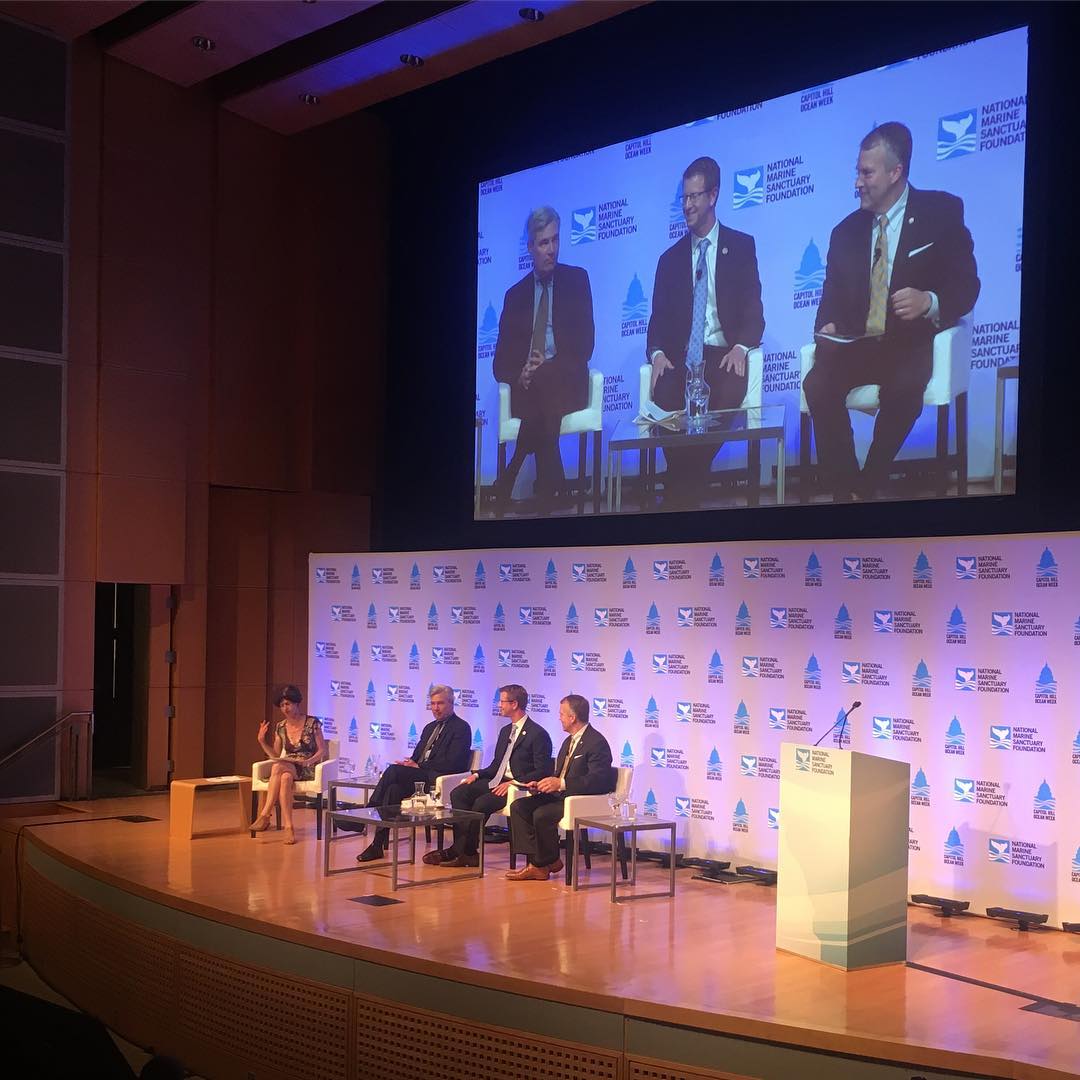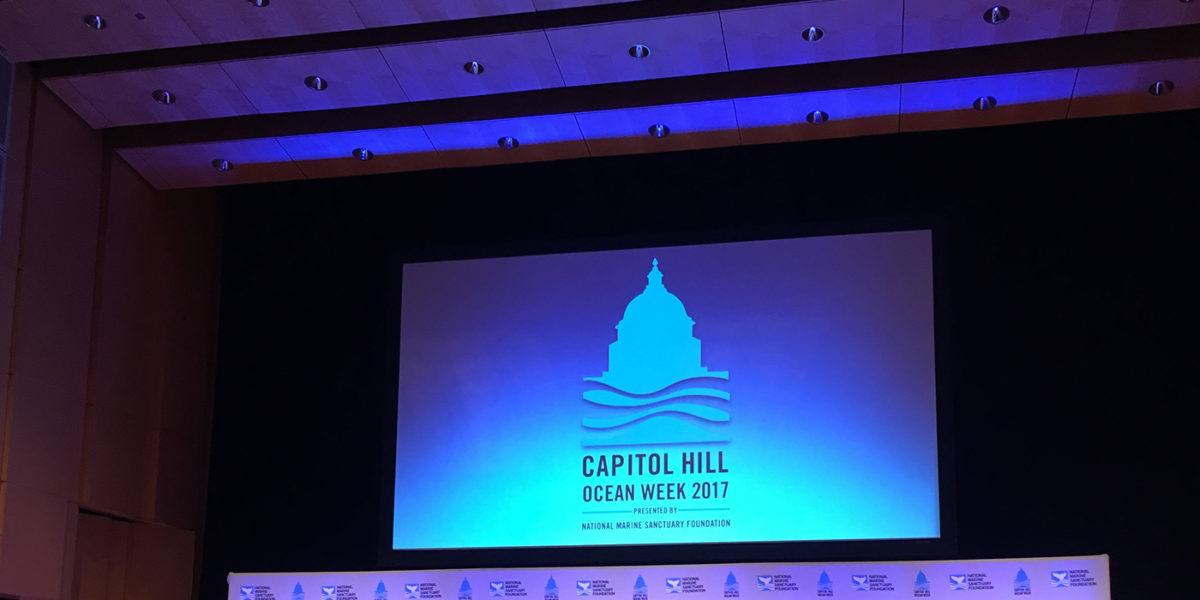When I was a little girl, I was afraid of the water. Not so afraid that I wouldn’t go in it, but I would never be the first one to take the plunge. I’d sacrifice my family and friends, quietly waiting a few beats to see if they were eaten by a shark or sucked down to core of the Earth by a surprise sinkhole—even in the lakes, rivers, and streams of my home state of Vermont, where we are stuck tragically without a salty coastline. After the scene appeared to be safe, I’d cautiously join them, only then able to enjoy the water with peace of mind.
Though my fear for the water eventually grew into curiosity, closely followed by deep passion for the ocean and its inhabitants, that little girl certainly never expected to find herself in attendance at Capitol Hill Ocean Week in Washington, D.C., a three-day event held in the Ronald Reagan Building and International Trade Center. At CHOW, as it is most commonly referred to, the foremost experts in all disciplines of marine conservation come together to present their projects and ideas and discuss the problems and potential solutions of the current state of our Great Lakes and coasts. The speakers were smart, passionate, admirable, and inspiring to a young person like me in their shared singular goal of preserving and protecting the ocean. As a college student/summer intern in attendance of the conference, I spent the week feverishly taking notes on every speaker and trying to imagine how I could possibly get to where they are today. When the final day came around, my cramping right hand and my rapidly-filling notebook were relieved, but I was sad to see the end so near.
After the final panel of the final day of CHOW, Kris Sarri, the President and CEO of the National Marine Sanctuary Foundation took the stage to conclude the week and piece together some of the motifs that she noticed throughout each discussion. The four that she came up with were empowerment, partnerships, optimism, and persistence. These are four great themes—they send an excellent message and do indeed capture what was discussed for three days in that amphitheater of the Ronald Reagan Building. However, I’d add one more: storytelling.

Kris Sarri, President & CEO of the National Marine Sanctuary Foundation
Again and again, storytelling was referenced as one of the most powerful tools in getting people to care about the environment and about conserving our ocean. Jane Lubchenco, former NOAA administrator, and one of the most accomplished and inspiring environmental scientists of our time, does not need to tell stories in order to get an audience full of ocean nerds to listen to her, but she did so, telling the story of the Obama administration’s near begging to get her to head NOAA. In doing so, she built rapport with all of us and won all of our hearts. Congressman Jimmy Panetta did the same thing by telling the story of listening to his daughter’s laughter as they watched seals play on the beach – he connected to all of us and tugged at joyful memories that we can all share. Patrick Pletnikoff, mayor of the small island Saint George in Alaska, was able to reach every audience member through the story of his tiny island home witnessing seal population decline, even though a vast majority of us have never even heard of Saint George, and probably can’t even picture it. Congressman Derek Kilmer struck us with his story of an indigenous tribe living on the coast of Puget Sound and experiencing sea level rise of over 100 yards through just one generation. Kilmer asserted to the audience, “It’s part of my job to tell their stories.” I can surely say that we were all moved, and we were ready to get behind the cause of helping this tribe to slow sea level rise.

Congressional Round table with Senator Whitehouse, Senator Sullivan, and Representative Kilmer
Even the speakers who didn’t tell stories of their own alluded to the value in stories and their power in connecting people. At the end of almost every single panel, the question was asked: “How can you communicate your views to people of opposite parties or people who don’t want to listen?” The response was always to find a way to connect to them and to bring it home to issues that they care about. The easiest and most effective way to do this is always through stories.
Stories help people connect with one another—it is why we as a society are obsessed with social media and constantly updating each other on the small moments of what goes on in our lives day to day, sometimes even minute by minute. I think that we can learn from this very obvious obsession that our society has, and use it to connect with people from across the aisle, and those who are staunchly unwilling to listen to our views. Those who are uninterested in hearing someone else’s laundry list of opposite ideals might be interested in a personal story from that person, illustrating their opinions rather than shouting them, and bringing to light what they have in common rather than what sets them apart. We all have something in common—our relationships, our emotions, our struggles, and our hopes— this is more than enough to begin sharing ideas and connecting with another person. I’m sure you, too, have once felt exhilarated and nervous to hear the speech of a person you admire. You, too, have once had a dream to live and work in a city you’ve never been to. You, too, might have once been scared to jump into the water. We can build from there.
With stories in my pocket and personal connections to real people both similar and different from me, I’m ready to take the plunge into the water alone— completely unafraid, and head first.

To learn more about this year’s agenda, visit CHOW 2017.







